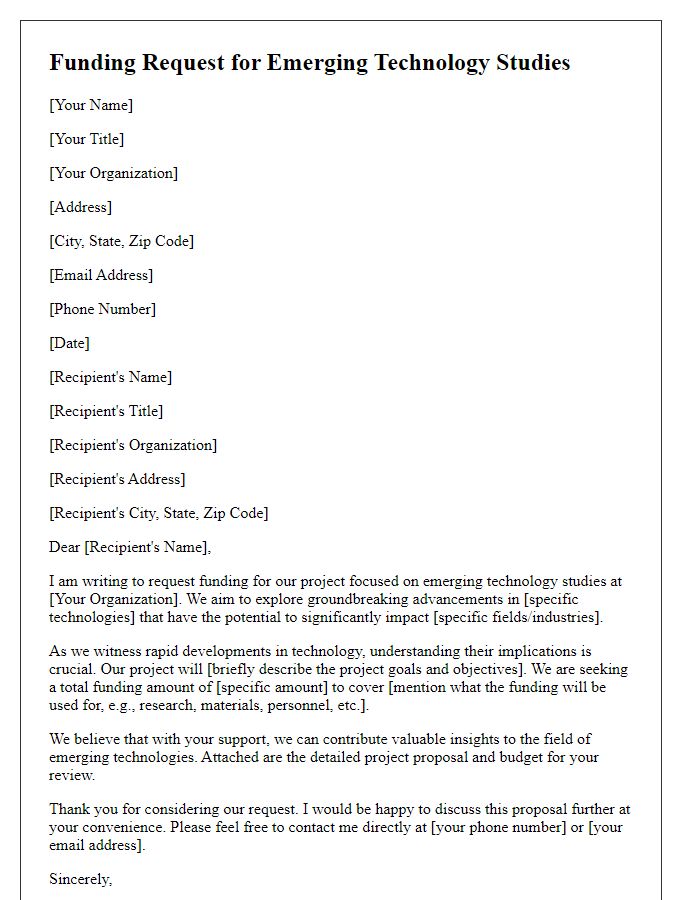Crafting a compelling letter for a technology research grant can be a pivotal step in securing funding for your innovative ideas. It's essential to articulate your vision clearly and showcase the potential impact of your research on the field. Highlighting your team's expertise and the uniqueness of your approach will help to capture the interest of grant reviewers. Read on to discover valuable tips and a comprehensive template that will elevate your letter and improve your chances of success!

Clear Research Objective
The research objective focuses on advancing quantum computing technology, specifically targeting fault-tolerance mechanisms within quantum algorithms. Quantum computing holds the potential to revolutionize fields such as cryptography, materials science, and complex system modeling. Achieving a reliable, scalable quantum computer requires overcoming significant issues related to qubit coherence and error rates, often exceeding 1% in current systems like superconducting qubits. This study aims to develop a novel error correction code, which could reduce operational errors to below 0.1%, significantly increasing the computational power of devices like Google's Sycamore processor, utilized in groundbreaking quantum supremacy experiments. The research will also explore practical implementations of these codes in existing architectures, fostering collaboration with institutions such as MIT and Stanford.
Detailed Budget Plan
A detailed budget plan for a technology research grant outlines the allocation of funds across various essential components. Personnel costs, including salaries for researchers and support staff, typically account for a significant portion, often exceeding 50% of the total budget, depending on project demands. Materials and supplies, covering essential resources such as advanced technology tools, laboratory equipment, and software licenses, might reach 20-30% of total expenditures. Travel expenses, including conferences and field research trips, generally require about 10%, facilitating collaboration with other institutions and networking opportunities. Additionally, facilities costs, related to the utilization of dedicated research spaces, can constitute approximately 5-10% of the budget. Finally, indirect costs, which account for administrative support and operational overhead, must also be specified, forming around 5-15% of the total project budget. Clear justification for each budget category demonstrates the necessity of funding in advancing the research objectives effectively.
Relevance to Funding Goals
Innovative technology research plays a pivotal role in addressing contemporary challenges faced by sectors such as healthcare, education, and renewable energy. As global populations surge, advancements in artificial intelligence (AI), machine learning (ML), and internet of things (IoT) become paramount for improving efficiency and effectiveness across industries. For instance, AI-powered diagnostic tools could potentially reduce patient wait times in hospitals by over 30% while increasing diagnostic accuracy. Furthermore, cutting-edge IoT applications in smart grid technology contribute significantly to reducing energy consumption by around 15%, aligning with sustainability goals set by international agreements like the Paris Accord. This research initiative aligns perfectly with the funding goals aimed at fostering innovative solutions that catalyze social progress and economic growth, especially in underserved communities that can greatly benefit from technological integration.
Strong Qualifications and Expertise
Accomplished researchers possess strong qualifications and expertise in technology innovations, demonstrated through their extensive academic backgrounds and relevant project experiences. Holding advanced degrees in fields such as Computer Science or Electrical Engineering from prestigious institutions, they have contributed significantly to notable conferences, including IEEE and ACM. Their previous projects, which include developing cutting-edge artificial intelligence algorithms, have garnered recognition from industry leaders and have been published in peer-reviewed journals. Furthermore, partnerships with organizations such as MIT Media Lab and Stanford Research Institute showcase their collaborative efforts in pushing boundaries of technology. Access to state-of-the-art laboratories and technical resources allows them to experiment and refine their methodologies, ensuring impactful advancements in technology research.
Potential Impact and Benefits
The advancement of renewable energy technology significantly impacts global sustainability efforts, particularly solar energy systems. As of 2023, the solar capacity in the United States surpassed 130 gigawatts, providing clean power to millions of homes. Research in this field can lead to the development of more efficient photovoltaic cells, potentially increasing energy conversion rates from the current average of 15-20% to over 30%. Innovations in battery storage technology can also mitigate energy intermittency issues, enabling a stable power supply. Additionally, research on materials such as perovskites may lower manufacturing costs, making solar installations accessible to underserved communities. The potential to create thousands of jobs in the green technology sector underscores the economic benefits alongside environmental improvements, supporting a transition to a low-carbon future.
Letter Template For Technology Research Grant Samples
Letter template of submission for research grant in computing technologies

Letter template of application for research and development technology funding

Letter template of proposal submission for digital technology research grant











Comments